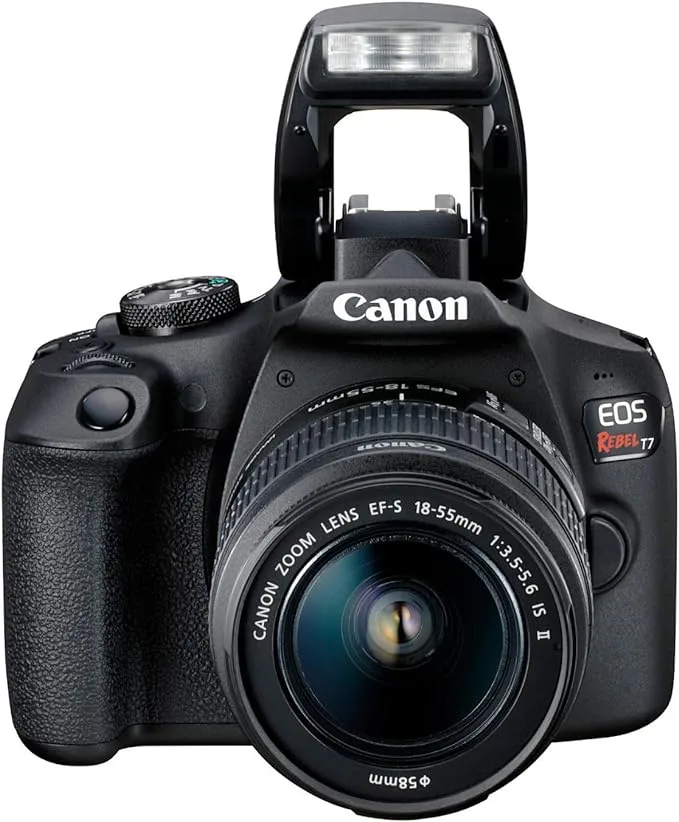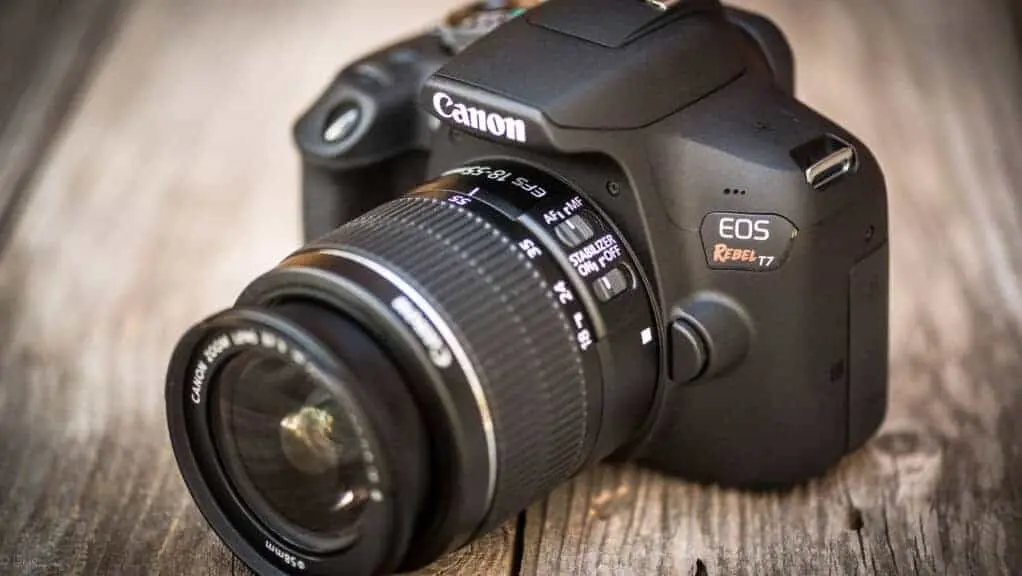Exploring the Features of Canon EOS Rebel T7 camera |REVIEW |
Exploring the Features of Canon EOS Rebel T7
Table of Contents

Use the EOS Utility Webcam Beta Software (Mac and Windows) to turn your compatible Canon camera into a high-quality webcam. Compatible Lenses- Canon EF Lenses (including EF-S lenses, excluding EF-M lenses).
| Specifications Canon EOS Rebel T7 | |
|---|---|
| Compatible Mountings | Canon EF |
| Photo Sensor Technology | CMOS |
| Supported File Format | RAW |
| Image Stabilization | true |
| Maximum Focal Length | 55 Millimeters |
| Metering Description | average,center-weighted,multi-zone,partial,spot |
| Brand | Canon |

Canon EOS Rebel T7 DSLR Camera with 18-55mm Lens
introduction of canon EOS Rebel T7
The Canon EOS Rebel T7 is more than just a camera. it’s a gateway to creative expression, In this review we delve into the remarkable features that make the EOS Rebel T7 a standout choice for both beginners and enthusiasts alike.
choose the power of its 24.1 Megapixel CMOS (APS-C) sensor, which delivers stunning detail and clarity in every shot. Unleash your creativity with the DIGIC 4+ Image Processor, ensuring fast, responsive performance for capturing fleeting moments with precision.
Explore the versatility of the EOS Rebel T7’s ISO range allowing you to confidently shoot in various lighting conditions from bright daylight to dimly lit environments. With its 9-point autofocus system, achieve sharp focus on your subjects, whether you’re capturing portraits, landscapes, or action shots.
Experience the joy of intuitive shooting with the EOS Rebel T7’s built in feature guide empowering you to unlock its full potential with ease. From capturing breathtaking Full HD videos to sharing your images instantly with built-in Wi-Fi and NFC connectivity, the possibilities are endless with the Canon EOS Rebel T7.
Canon EOS Rebel T7 DSLR Camera with 18-55mm Lens.
Find the best deals and discounts on the Canon EOS Rebel T7 DSLR camera..
Design
After using Canon cameras for a couple of years, I’ve come to appreciate their consistent and user-friendly design, a trait that holds true for the Canon EOS Rebel T7. Comparing it side by side with the Nikon D3400 and Sony Alpha 7 II, it’s evident that Canon has neatly positioned all the buttons on the right side of the camera. This placement, near the thumb rest, greatly simplifies accessing various settings during shooting.

When examining the overall layout these three cameras share many similarities. The Canon T7 features a convenient rotating knob on top, offering 14 different shooting modes from automatic to specialized modes like food photography. Atop the camera, you’ll also find the on/off switch, manual flash button, a customizable wheel for adjusting settings, and, notably, the shutter-release button.
Performance: Underwhelming
The Canon EOS Rebel T7 maintains the same 9-point autofocus system as its predecessor, the T6. It boots up and captures an image in approximately 0.6 seconds. In well-lit conditions, focus locks in swiftly at 0.1 seconds, but this duration extends to about 0.6 seconds in dim lighting. While subject tracking is an option, it requires switching the focus mode to AI Servo, and burst shooting is limited to a modest 3 frames per second (fps). In comparison, the Sony a6000 outpaces it with 11fps subject tracking capabilities.
When it comes to shooting duration, it’s contingent on the file format. Shooting in JPG mode allows for a respectable 76 photos before the buffer fills. However, opting for Raw format yields only 10 shots, and a mere six in Raw+JPG, with a buffer clear time of around 15 seconds.
On the downside, Live View focus proves sluggish. In optimal lighting conditions, it takes approximately 1.4 seconds to achieve focus using the rear display, while in dim lighting, this time extends to an average of 5.7 seconds. Such lag is notably subpar for a camera released in 2015, and upgrading to any other current Canon SLR provides significantly quicker Live View focus performance, nearly on par with through-the-viewfinder focus.
Image Quality: A Bright Spot
The primary function of a camera is to capture images, and in this aspect, the T7 excels. Despite using an older image processor, its 24MP image sensor places it on par with its competitors. Examination of images from our ISO test scene reveals that the T7 produces sharp and clear JPGs up to ISO 1600. However, a slight blur becomes noticeable at ISO 3200, the highest setting with noise levels below 1.5 percent, with more pronounced blurring at ISO 6400. While ISO 12800 is available, accessing it requires navigating through the menu and enabling it manually, as automatic adjustment is capped at ISO 6400.

When shooting in Raw format, the T7 maintains image clarity with minimal grain up to ISO 3200. Detail retention remains commendable at ISO 6400, although grain becomes more pronounced. However, neither Raw nor JPG formats support settings higher than ISO 6400 due to limitations of the image processor. In contrast, the T7i and SL2 offer ISO 25600 capture, particularly useful in low-light conditions.
Video: Where’s the Autofocus?
The T7 offers video recording capabilities up to 1080p, with frame rates of 24fps and 30fps. While the video quality is decent, it may not match the pinnacle of 1080p standards, yet it certainly doesn’t rank as the worst either. However, those seeking professional-grade results may find it lacking, especially without a microphone input—a crucial feature for serious videographers who often require 4K resolution.

On the other hand, casual users may prioritize a camera with reliable autofocus during video recording. While the T7’s autofocus system can set focus before recording begins, it remains inactive while filming. Manual focus adjustment is possible, although the SL2 and T7i offer superior video autofocus capabilities, characterized by their speed, smoothness, and user-friendliness. For those prioritizing video recording these models present more appealing options.
Conclusions: Better Ways to Spend Your Money
Similar to its predecessor the T6 the T7 disappoints as an entry level offering from Canon, a brand renowned for its quality cameras. While Canon possesses the know how to craft exceptional cameras, the T7 falls short lacking necessary refinements to elevate its performance. Compared to other models on the market, the T7 lags behind, failing to match their standards.
For budget-conscious consumers seeking an entry-level SLR, the Nikon D3400 emerges as a superior choice, offering better image quality and the ability to autofocus during video recording, albeit not as smoothly as Canon SLRs or most mirrorless cameras.
Alternatively, Canon loyalists may find better options in the SL2 and T7i, albeit at slightly higher price points. Meanwhile the Sony A6000 presents a compelling mirrorless alternative boasting strong image quality and swift focus in a compact form factor.
It’s disheartening that Canon seems content with the T7, as customers rightfully expect the leading name in cameras to deliver competitive products in the entry-level SLR and mirrorless camera categories. While low-cost options may not match the performance of professional-grade cameras, they should at least hold their own against similarly priced alternatives—a standard the T7 fails to meet.
Canon EOS Rebel T7.
24.1 Megapixel CMOS (APS-C)sensor with is 100–6400 (H: 12800)Built-in Wi-Fi and NFC technology.
One thought on “Exploring the Features of Canon EOS Rebel T7 camera |REVIEW |”